天津科技大学生物反应工程课程PDF精讲课件教案合辑(共621页)
- 格式:pdf
- 大小:8.31 MB
- 文档页数:621

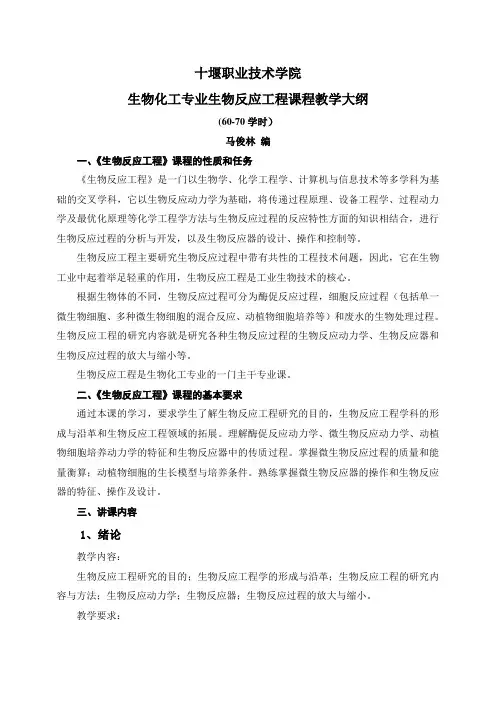
十堰职业技术学院生物化工专业生物反应工程课程教学大纲(60-70学时)马俊林编一、《生物反应工程》课程的性质和任务《生物反应工程》是一门以生物学、化学工程学、计算机与信息技术等多学科为基础的交叉学科,它以生物反应动力学为基础,将传递过程原理、设备工程学、过程动力学及最优化原理等化学工程学方法与生物反应过程的反应特性方面的知识相结合,进行生物反应过程的分析与开发,以及生物反应器的设计、操作和控制等。
生物反应工程主要研究生物反应过程中带有共性的工程技术问题,因此,它在生物工业中起着举足轻重的作用,生物反应工程是工业生物技术的核心。
根据生物体的不同,生物反应过程可分为酶促反应过程,细胞反应过程(包括单一微生物细胞、多种微生物细胞的混合反应、动植物细胞培养等)和废水的生物处理过程。
生物反应工程的研究内容就是研究各种生物反应过程的生物反应动力学、生物反应器和生物反应过程的放大与缩小等。
生物反应工程是生物化工专业的一门主干专业课。
二、《生物反应工程》课程的基本要求通过本课的学习,要求学生了解生物反应工程研究的目的,生物反应工程学科的形成与沿革和生物反应工程领域的拓展。
理解酶促反应动力学、微生物反应动力学、动植物细胞培养动力学的特征和生物反应器中的传质过程。
掌握微生物反应过程的质量和能量衡算;动植物细胞的生长模型与培养条件。
熟练掌握微生物反应器的操作和生物反应器的特征、操作及设计。
三、讲课内容1、绪论教学内容:生物反应工程研究的目的;生物反应工程学的形成与沿革;生物反应工程的研究内容与方法;生物反应动力学;生物反应器;生物反应过程的放大与缩小。
教学要求:熟练掌握生物反应工程的概念,生物反应工程的研究内容与方法;理解生物反应工程研究的目的;了解生物反应工程学科的形成与沿革,生物反应过程的放大与缩小。
教学重点:生物反应动力学和生物反应器。
教学建议:教学中注意和化学反应动力学及化学反应器进行比较。
2、酶促反应动力学教学内容:酶促反应动力学的特点;酶的基本概念;酶的稳定性及应用特点;酶和细胞的固定化技术;酶促反应的特征。
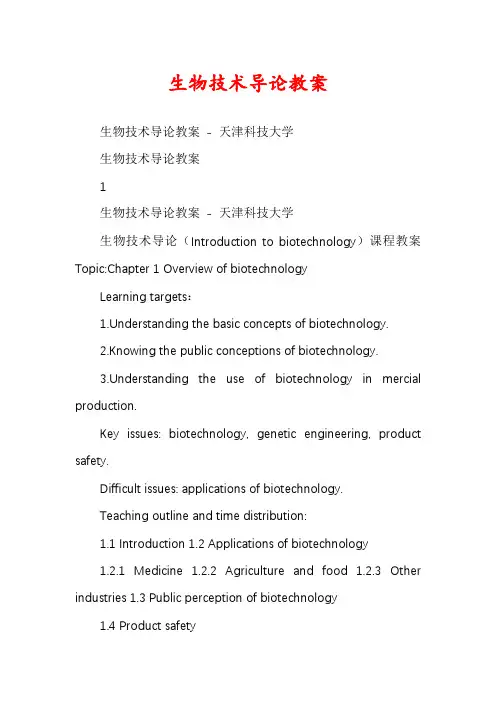
生物技术导论教案生物技术导论教案- 天津科技大学生物技术导论教案1生物技术导论教案- 天津科技大学生物技术导论(Introduction to biotechnology)课程教案Topic:Chapter 1 Overview of biotechnologyLearning targets:1.Understanding the basic concepts of biotechnology.2.Knowing the public conceptions of biotechnology.3.Understanding the use of biotechnology in mercial production.Key issues: biotechnology, genetic engineering, product safety.Difficult issues: applications of biotechnology.Teaching outline and time distribution:1.1 Introduction 1.2 Applications of biotechnology1.2.1 Medicine 1.2.2 Agriculture and food 1.2.3 Other industries 1.3 Public perception of biotechnology1.4 Product safety1.5 The future of biotechnology Methodology:1.Describe the principles with help of practical cases;2.Show pictures and photos;3.Ask questions and summarizing;4.Multiple media and handwriting;2生物技术导论教案- 天津科技大学Chapter 1 Overview of biotechnology1.1I ntroductionBiotechnology is technology based on biology, especially when used in agriculture, food science, medicine, and environment. United Nations Convention on Biological Diversity defines bi otechnology as: “Any technological application that uses biological systems, dead organisms, or derivatives thereof, to make or modify products or processes for specific use.” And The European Federation of Biotechnology (EFB) considers biotechnology as “t he integration of natural sciences and organisms, cells, parts thereof, and molecular analogues for products and services.”In simple words biotechnology is any technological application which is used to make a change in a cell or inbiological system. Biotechnology draws on the pure biological sciences (genetics, microbiology, cell biology, molecular biology, biochemistry) and in many instances is also dependent on knowledge and methods from outside the sphere of biology (physics, chemistry, mathematics). Conversely, modern biological sciences (including even concepts such as molecular ecology) are intimately dependent on the methods developed through biotechnology.Historically, biotechnology evolved as an agricultural skill rather than a science. Through early biotechnology, farmers were able to use microbes to produce foods and beverages, such as bread and beer, and to modify plants and animals through progressive selection for desired traits.The new biotechnology revolution began in the 1970s and early 1980s when scientists learned to alter precisely the genetic constitution of living organisms by processes outside of traditional breeding practices. This ‘genetic engineering’ has had a profound impact on almost all areas of traditional biotechnology and further permitted breakthroughs in medicine and agriculture, in particular, that would be impossible by traditional breeding approaches.Some of the most exciting advances will be in new pharmaceutical drugs and therapies to improve the treatment of many diseases, and in the production of healthier foods, selective pesticides and innovative environmental technologies.Since the 1980s biotechnology has been recognized and accepted as a strategic technology by most industrialized nations. Revenue in the industry over the world is expected to be more than 130 billion US dollars in 2007, and to grow by 12.9% in 2008. The economic returns from investing in strategic technologies accrue not just to3生物技术导论教案- 天津科技大学the panies conducting research and development (RD) but more importantly returns to society overall are estimated to be even higher.The present industrial activities to be affected most will include human and animal food production, provision of chemical feed stocks to replace petrochemical sources, alternative energy sources, waste recycling, pollution control, agriculture, aquaculture and forestry.1.2A pplications of biotechnology1.2.1MedicineMost traditional pharmaceutical drugs are relatively simple molecules that have been found primarily through trial and error to treat the symptoms of a disease or illness. Biopharmaceuticals are large biological molecules known as proteins and these usually target the underlying mechanisms and pathways of a disease. It is a relatively young industry. They can deal with targets in humans that may not be accessible with traditional medicines.Biotechnology is monly associated with landmark breakthroughs in new medical therapies to treat hepatitis B, hepatitis C, cancers, arthritis, haemophilia, bone fractures, multiple sclerosis, and cardiovascular disorders. The biotechnology industry has also been instrumental in developing molecular diagnostic devices that can be used to define the target patient population for a given biopharmaceutical.Modern biotechnology can be used to manufacture existing medicines relatively easily and cheaply. The first genetically engineered products were medicines designed to treat human diseases. Modern biotechnology has evolved, making it possible to produce more easily and relatively cheaply human growth hormone, clotting factors for hemophiliacs, fertility drugs,erythropoietin and other drugs. Most drugs today are based on about 500 molecular targets. Genomic knowledge of the genes involved in diseases, disease pathways, and drug-response sites are expected to lead to the discovery of thousands more new targets.1.2.2Agriculture and foodAgriculture and Food is more important economically than health-care, even in western countries, and is clearly of much greater concern to the rest of the world.Biotechnology has been widely used in agriculture and food in many areas. For example, using the techniques of modern biotechnology, one or two genes may be transferred to a highly developed crop variety to impart a new character that would increase its yield. Moreover, crops containing genes that will enable them to4生物技术导论教案- 天津科技大学withstand environmental stresses may be developed.Biotechnological methods for improving field crops, such as wheat, corn and soybeans, are also being sought, since seeds serve both as a source of nutrition for people and animals and asthe material for producing the next plant generation. By increasing the quality and quantity of protein or varying the types in these crops, we can improve their nutritional value.Modern biotechnology can also be used to slow down the process of spoilage so that fruit can ripen longer on the plant and then be transported to the consumer with a still reasonable shelf life. This alters the taste, texture and appearance of the fruit. More importantly, it could expand the market for farmers in developing countries due to the reduction in spoilage.1.2.3Other industriesMany other industries could, in principle, benefit from biotechnology. The fabric and textiles industries are using biotechnology quite substantially, using enzymes to treat textiles and leather, for example. The paper pulp industry is taking up biotechnology rapidly as a cleaner alternative to chemical and mechanical processes. The plastics industry also uses some polymers made by micro-organisms.Other biomaterials such as xanthan gums are used in some specialized industrial applications, but this is rare and opportunistic, and usually does not exploit our systematic knowledge of biological systems, but only our accidentalknowledge of their properties and products. This is because oil is very cheap, and the industry for converting it into products is flexible, efficient and sophisticated.1.3P ublic perception of biotechnologyWhile biotechnology presents enormous potential for healthcare and the production, processing and quality of foods through genetic engineering of crops, fertilizers, pesticides, vaccines and various animal species, the implications of these new biotechnological processes go well beyond the technical benefits offered.Central to most of the debates about biotechnology is the single main issue C should regulation be dependent on the characteristics of the products modified by (rDNA) technology? The product versus process debate has continued for many years and exposes conflicting views on what should represent public policies on new technology development. What is public interest? Should this be left to the scientists and technologists to decide, or should the ‘public’ e part of such decision-making processes? The many crucial decisions to be made will affect the5生物技术导论教案- 天津科技大学future of humanity and the planet’s natural res ources.In fact, public debate is essential for new biotechnology to grow up, and undoubtedly for the foreseeable future biotechnology will be under scrutiny. Public understanding of these new technologies could well hasten public acceptance. However, the low level of scientific literacy (e.g. in the USA where only 7% are scientifically literate) does mean that most of the public will not be able to draw informed conclusions about important biotechnology issues. Consequently, it is conceivable that a small number of activists might argue the case against genetic engineering in such emotive and ill-reasoned ways that both the public and the politicians are misled. The biotechnology munity needs to sit up and take notice of, and work with, the public. People influence decision-making by governments through the ballot box or through the presence of public opinion.While genetic engineering is an immensely plicated subject, not easily explained, that doesn’t mean that it must remain, in decision-making terms, only in the control of the scientist, industrialist or politician. There is no doubt that many of the public or consumers are interested in the science of genetic engineering but are unable to understand the plexity of thissubject. Furthermore, genetic engineering and its myriad of implications must not be beyond debate. Public attitudes to genetic engineering will influence its evolution and marketplace applications. It is important for public confidence for everyone to recognize that all science is fallible-especially plex biological science. All too often press and TV reports on genetic engineering present the discoveries as absolute certainties when this is rarely the case1.4 Product safetyMuch debate is now taking place on the safety and ethical aspects of genetically modified organisms (GMOs) and their products destined for public consumption. Can such products with ‘unnatural’ gene changes lead to unforeseen problems for present and future generations?The safety of the human food supply is of critical importance to most nations and all foods should be fit for consumption i.e. not injurious to health or contaminated. When foods or food ingredients are derived from GMOs they must be seen to be as safe as, or safer than, their traditional counterparts. The concept of substantial equivalence is widely applied in the determination of safety by parison with analogous conventional food productstogether with intended use and exposure.When such novel products are moving into the marketplace the consumer must be assured of their quality and safety. Thus there must be toxicological and nutritional6生物技术导论教案- 天津科技大学guidance in the evolution of novel foods and ingredients to highlight any potential risks which can then be dealt with appropriately. Safety assessment of novel foods and food ingredients must satisfy the producer, the manufacture, the legislator and the consumer. The approach should be in line with accepted scientific considerations, the results of the safety assessment must be reproducible and acceptable to responsible health authorities and the e must satisfy and convince the consumer.In biotechnology, governmental regulations will represent a critical determinant of the time and total costs in bringing a pro duct to market. Regulatory agencies can act as ‘gate-keepers’ for the development and availability of new biotechnology products, but can also erect considerable barriers to industrial development.1.5 The future of biotechnologyBiotechnology is increasingly being viewed as a Promethean science, because in so many ways it is transforming the relationship between humans and the planet. In recent years biotechnology has been shown to be a spectrum of enabling technologies, which are increasingly being applied in many aspects of modern society. A central feature of new biotechnological advances derives from an increasing understanding of the mechanisms of life and how these will eventually transform human lives, as well as giving a deeper appreciation of agriculture, aquaculture, forestry and the biological environment. The ability to select and manipulate genetic material within and outside species has permitted unprecedented opportunities to alter life forms for the benefit of society.Many molecular biologists have postulated that a genetic or DNA sequence analysis of an individual could be predictive of future disease occurrence, e.g. cardiovascular, cancer, Alzheimer’s, etc. Undoubtedly, there will be continued research and application in this area. The further implementation of genomics and proteomics will allow a much deeperunderstanding of the biology of molecules, cells and whole organisms. Doctors and patients will have much to gain from the e of these studies. Much will be learned about human individuality and how these findings could influence individual health and disease susceptibility.Plant-based genetic engineering started in the early 1980s with the development of the Ti plasmid of Agrobacterium, which has allowed the introduction of simple genetic constructs into most of the important crop plants. There is increasing evidence that GM crops are giving significant yield increases, savings for growers and pesticide use reductions in both developed and developing countries. Yet another important feature of certain GM plants is that they use less water, and undoubtedly in many 7生物技术导论教案- 天津科技大学parts of the world water availability will be the determining factor for successful food production by both animals and plants.The new aspects of biotechnology such as biofuel will bring huge benefits to humankind. Climate change is now a worldwide recognized concern. A number of approaches are now being considered to counter the effects of global warming. From abiotechnological consideration biofuel development has gained international recognition and a wide range of options are being progressed to determine which biofuels can e cost-effective alternatives to fossil fuels..In summary, biotechnology will play a major role in the continued search for solutions to the many problems that will affect the society of tomorrow: health, food supply and a safe biological environment. And more scientific research will be continued to achieve these ends.1.6 Further readingFumento M. (2003). Bioevolution: How Biotechnology is Changing our World. Encounter Books, USA.John E. Smith (2009). Biotechnology (5th edition). Cambridge University Press, UK.8生物技术导论教案- 天津科技大学9生物技术导论教案- 天津科技大学Chapter 2 BioreactorBioreactors are the containment vehicles of any biotechnology-based production process, be it for brewing,organic or amino acids, antibiotics,enzymes, vaccines or for bioremediation. For each biotechnology process the most suitable containment system must be designed to give the cor-rect environment for optimising the growth and metabolic activity of the biocatalyst. Bioreactors range from simple stirred or non-stirred open con-tainers to plex aseptic integrated systems involving varying levels of advanced puter control (Fig.1).Bioreactors occur in two distinct types (Fig.1. In the ?rst instance they are primarily non-aseptic systems where it is not absolutely essential to operate with entirely pure cultures, e.g. brewing, ef?uent disposal sys-tems; while in the second type, aseptic conditions are a prerequisite for successful product formation, e.g. antibiotics, vitamins, polysaccharides and binant proteins. This type of process involves considerable chal-lenges on the part of engineering construction and operation.The physical form of many of the most widely used bioreactors has not altered much over the past forty years; however, in recent years, novel forms of bioreactors have been developed to suit the needs of speci?c bioprocesses and such innovations are ?nding increasingly specialised roles in bioprocess technology (Fig.1).In all forms of fermentation the ultimate aim is to ensure that all parts of the system are subject to the same conditions. Within the bioreactor the microorganisms are suspended in the aqueous nutrient medium con-taining the necessary substrates for growth of the organism and required product formation. All nutrients, including oxygen, must be provided to diffuse into each cell and waste products such as heat, carbon dioxide and waste metabolites removed.10生物技术导论教案- 天津科技大学Fig. 1 Various forms of bioreactor.(a) Continuous stirred tank reactor.(b) Tower reactor.(c) Loop (recycle) bioreactor.(d) Anaerobic digester or bioreactor.11生物技术导论教案- 天津科技大学(e) Activated sludge bioreactor. (Source: (a) and (b)reproduced by permission from Kristiansen and Chamberlain, 1983.)Table1 Standards of materials used in sophisticatedfermenter designThe concentration of the nutrients in the vicinity of the organismmust be held within a de?nite range since low values will limit the rate of organ-ism metabolism while excessive concentrations can be toxic. Biological reactions run most ef?ciently within optimum ranges of environmental parameters, and in biotechnological processes these conditions must be provided on a micro-scale so that each cell is equally provided for. When the large scale of many bioreactor systems is considered it will be realized how dif?cult it is to achieve these conditions in a whole population. It is here that the skills of the process or biochemical engineer and the micro-biologist must e together.Fermentation reactions are multiphase, involving a gas phase (containing N2,O2 and CO2), one or more liquid phases (aqueous medium and liquid substrate) and solid microphase (the microorganisms and possibly solid substrates). All phases must be kept in close contact to achieve rapid mass and heat transfer. In a perfectly mixed bioreactor all reactants entering the system must be immediately mixed and uniformly distributed to ensure homogeneity inside the reactor.To achieve optimisation of the bioreactor system, the following operating guidelines must be closely adhered to:(1) the bioreactor should be designed to exclude entrance of contaminating organisms as well as containing the desired organisms(2) the culture volume should remain constant, i.e. no leakage or evaporation(3) the dissolved oxygen level must be maintained above critical levels of aeration and culture agitation for aerobic organisms(4) environmental parameters such as temperature, pH, etc., must be con-trolled and the culture volume must be well mixed.The standard of materials used in the construction of sophisticated fermenters is12生物技术导论教案- 天津科技大学important (Table 1).Fermentation technologists seek to achieve a maximisation of culture potential by accurate control of the bioreactor environment. But still there is a great lack of true understanding of just what environmental conditions will produce an optimalyield of organism or product. Organisms with large cell size, such as animal cells pared to bacteria, have a plex demand for nutrients and lower growth rate. On the other hand their ability to produce plicated proteins is increased.Successful bioprocessing will only occur when all the speci?c growth-related parameters are brought together, and the information used to improve and optimise the process. For successful mercial operation of these bioprocesses quantitative description of the cellular processes is an essential prerequisite: the two most relevant aspects, yield and productivity, are quantitative measures that will indicate how the cells convert the substrate into the product. The yield represents the amount of product obtained from the substrate while the productivity speci?es the rate of product formation.To understand and control a fermentation process it is necessary to know the stateof the process over a small time increment and, further, to know how the organism responds to a set of measurable environmental conditions. Process optimisation requires accurate and rapid feedback control. In the future, the puter will be an integral part of most bioreactor systems. However, there is a lackof good sensor probes that will allow on-line analysis to be made on the chemical ponents of the fermentation process.A large worldwide market exists for the development of new rapid methods monitoring the many reactions within a bioreactor. In particular, the greatest need isfor innovatory microelectronic designs.When endeavouring to improve existing process operations or design it is often advisable to set up mathematical models of the overall system. A model is a set of relationships between the variables in the system being studied. Such relationships are usually expressed in the form of mathe-matical equations but can also be speci?ed as cause/effect relationships,which can be used in the operation of the speci?c processes. The actual variables involved can be extensive but will include any parameter that is of importance for the process and can include: pH, temperature, substrate concentration, agitation, feed rate, etc.Bioreactor con?gurations have changed considerably over the last few decades. The original fermentation system was a shallow tank agitated or stirred by manpower.13生物技术导论教案- 天津科技大学From this has developed the basic aeration tower system, which now dominates industrial usage. As fermentation systems were further developed, two design solutions to the problems of aeration and agitation have been implemented. The ?rst approach uses mechanical aeration and agitation devices, with relatively high power requirements;the standard example is the centrally stirred tank reactor (CSTR), which is widely used throughout conventional laboratory and industrial fermentations. Such bioreactors ensure good gas/liquid mass transfer, have reason-able heat transfer, and ensure good mixing of the bioreactor contents.The vertical shaft of the CSTR will carry one or more impellers depending on size of the bioreactor (Fig.1a). A broad range of impellers have been investigated for stirring and creating homogeneous conditions within the bioreactor. The impellers are usually spaced at intervals equivalent to one tank diameter along the shaft to avoid a swirling type of liquid movement. The six ?at-bladed (Rushton) turbine impellers are used in the majority of bioreactors and normally three to ?ve are mounted to achieve good mixing and dispersion throughout the system. The function of the impellers is to create agitation or mixing within thebioreactor and to facilitate aera-tion. The primary function of agitation is to suspend the cells and nutrient evenly throughout the medium, to ensure that the nutrients, including oxygen, are available to the cells and to allow heat transfer. Most industrial organisms are aerobic and, in most fermentations, the organisms will exhibit a high oxygen demand. Since oxygen is sparingly soluble in aqueous solutions (solubility of CO2 in water is about 30 times higher than that of O2) aerobic fermentations can only be supported by vigorous and constant aeration of the medium.The second main approach to aerobic bioreactor design uses air distribution (with lowpower consumption) to create forced and controlled liquid ?ow in a recycle or loop bioreactor. In this way the contents are subjected to a controlled recycle ?ow, either within the bioreactor or involving an external recycle loop. Thus stirring has been replaced by pumping, which may be mechanical or pneumatic, as in the case of the airlift bioreactor.The centrally stirred tank reactor consists of a cylindrical vessel with a motor-driven central shaft that supports one or several agitators with the shaft entering either through the top or the bottom of the vessels. The aspect ratio (i.e. height-to-diameter ratio) of the vessel is three to ?ve for microbial systemswhile for mammalian cell culture the aspect ratios do not normally exceed two. Sterile air is sparged into the bioreactor liquid below the bottom impeller by way of a perforated14生物技术导论教案- 天津科技大学ring sparger. The speed of the impellors will be related to the degree of fragility of the cells. Mammalian cells are extremely fragile when pared to most microorganisms. In a greatmany of the high-value processes the bioreactors will be operated in a batch manner under aseptic monoculture. The bioreactors can range fromc. 20L to in excess of 790m3 for particular processes. The initial culture expansion of the microorganisms will mence in the smallest bioreactor, and when growth is optimised it will then be transferred to a larger bioreactor, and so forth, until the ?nal operation bioreactor. Throughout such operations it is imperative tomaintain aseptic conditions to ensure the success of the process. Bioreactors are normally sterilised prior to inoculation and contaminationmust be avoided during all subsequent operations.If contamination occurs during the cultivation this will invariably lead to process failure since more often than not the contaminant can outgrow the participating monoculture.The number of distinct types of bioreactor is quite limited when measured against the wide range of production processes and the varied biological systems involved. In industrial practice, and less as a result of special advantage than as a need for ?exibility in production equipment, the CSTR now occupies a dominant position and is virtually the only bioreactor design used in full-scale bioprocessing. Large amounts of organic waste waters from domestic and industrial sources are routinely treated in aerobic and anaerobic systems. Activated sludge processes are widely used for the oxidative treatment of sewage and other liquid wastes (Fig. 1d). Such processes use batch or continuous agitated bioreactor systems to increase the entrainment of air to optimize oxidative breakdown of the organic material. These bioreactors are large and for optimum functioning will have several or many agitator units to facilitate mixing and oxygen uptake. They are widely used in most municipal sewage treatment plants.Anaerobic bioreactors or digestors have long been used to treat sewage matter. In the absence of free oxygen certain microbial consortia are able to convert biodegradable organicmaterial tomethane, carbon dioxide and new microbialbiomass. Most mon anaerobic digesters work on a continuous or semi-continuous manner.An outstanding example of methane generation is the Chinese biogas programme where millions of family-size anaerobic bioreactors are in operation. Such bioreactors are used for treatment of manure, human excreta, etc., producing biogas for cooking and lighting and the sanitisation of the waste, which then es an excellent fertiliser. In almost all fermentation processes performed in a bioreactor there is generally a need to measure speci?c growth-related and environmental parameters, record them and then use the information to improve and optimise the process.15生物技术导论教案- 天津科技大学Bioreactor control measurements are made in either an on-line or an off-line manner. With an on-line measurement the sensor is placed directly within the process stream whereas for off-line measurement a sample is removed aseptically from the process stream and analysed. Bioreactor processing is still severely limited by a shortage of reliable instruments capable of on-line measurement of important variables such as DNA, RNA,。
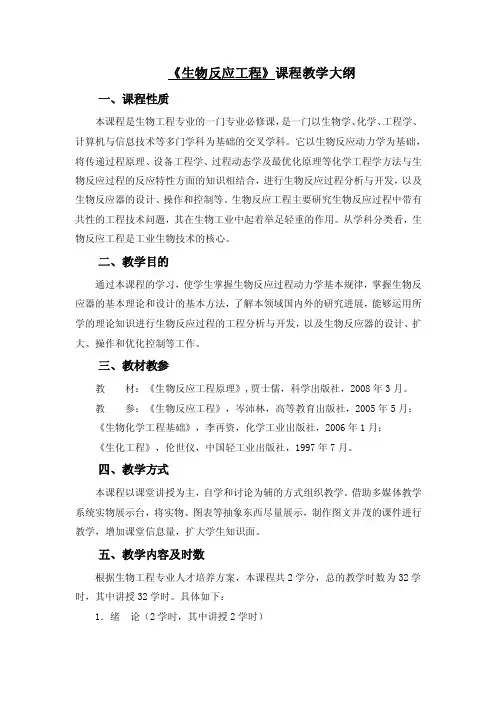
《生物反应工程》课程教学大纲一、课程性质本课程是生物工程专业的一门专业必修课,是一门以生物学、化学、工程学、计算机与信息技术等多门学科为基础的交叉学科。
它以生物反应动力学为基础,将传递过程原理、设备工程学、过程动态学及最优化原理等化学工程学方法与生物反应过程的反应特性方面的知识相结合,进行生物反应过程分析与开发,以及生物反应器的设计、操作和控制等。
生物反应工程主要研究生物反应过程中带有共性的工程技术问题,其在生物工业中起着举足轻重的作用。
从学科分类看,生物反应工程是工业生物技术的核心。
二、教学目的通过本课程的学习,使学生掌握生物反应过程动力学基本规律,掌握生物反应器的基本理论和设计的基本方法,了解本领域国内外的研究进展,能够运用所学的理论知识进行生物反应过程的工程分析与开发,以及生物反应器的设计、扩大、操作和优化控制等工作。
三、教材教参教材:《生物反应工程原理》,贾士儒,科学出版社,2008年3月。
教参:《生物反应工程》,岑沛林,高等教育出版社,2005年5月;《生物化学工程基础》,李再资,化学工业出版社,2006年1月;《生化工程》,伦世仪,中国轻工业出版社,1997年7月。
四、教学方式本课程以课堂讲授为主,自学和讨论为辅的方式组织教学。
借助多媒体教学系统实物展示台,将实物、图表等抽象东西尽量展示,制作图文并茂的课件进行教学,增加课堂信息量,扩大学生知识面。
五、教学内容及时数根据生物工程专业人才培养方案,本课程共2学分,总的教学时数为32学时,其中讲授32学时。
具体如下:1.绪论(2学时,其中讲授2学时)基本内容:本课程的学科性质、研究内容、及学科的形成与发展。
重点:生物反应工程的定义、生物反应工程研究的目的、生物反应工程的研究内容与方法。
难点:生物反应工程的定义和生物反应工程研究的目的、生物反应工程的研究内容与方法。
新知识点:生物反应工程的定义、生物反应工程研究的目的、生物反应工程的研究内容与方法。

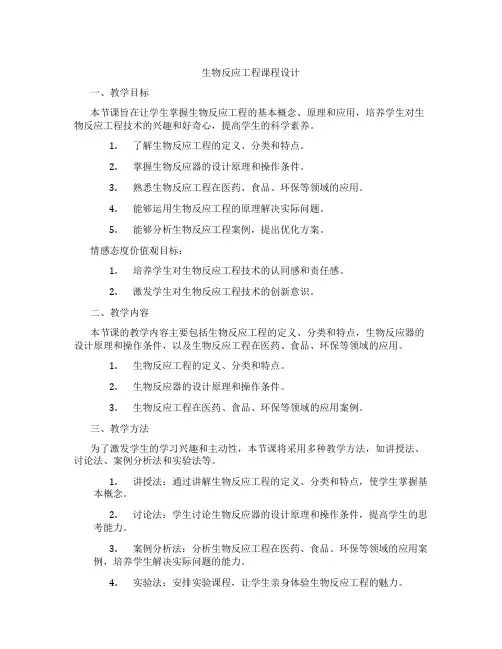
生物反应工程课程设计一、教学目标本节课旨在让学生掌握生物反应工程的基本概念、原理和应用,培养学生对生物反应工程技术的兴趣和好奇心,提高学生的科学素养。
1.了解生物反应工程的定义、分类和特点。
2.掌握生物反应器的设计原理和操作条件。
3.熟悉生物反应工程在医药、食品、环保等领域的应用。
4.能够运用生物反应工程的原理解决实际问题。
5.能够分析生物反应工程案例,提出优化方案。
情感态度价值观目标:1.培养学生对生物反应工程技术的认同感和责任感。
2.激发学生对生物反应工程技术的创新意识。
二、教学内容本节课的教学内容主要包括生物反应工程的定义、分类和特点,生物反应器的设计原理和操作条件,以及生物反应工程在医药、食品、环保等领域的应用。
1.生物反应工程的定义、分类和特点。
2.生物反应器的设计原理和操作条件。
3.生物反应工程在医药、食品、环保等领域的应用案例。
三、教学方法为了激发学生的学习兴趣和主动性,本节课将采用多种教学方法,如讲授法、讨论法、案例分析法和实验法等。
1.讲授法:通过讲解生物反应工程的定义、分类和特点,使学生掌握基本概念。
2.讨论法:学生讨论生物反应器的设计原理和操作条件,提高学生的思考能力。
3.案例分析法:分析生物反应工程在医药、食品、环保等领域的应用案例,培养学生解决实际问题的能力。
4.实验法:安排实验课程,让学生亲身体验生物反应工程的魅力。
四、教学资源为了支持教学内容和教学方法的实施,丰富学生的学习体验,我们将选择和准备以下教学资源:1.教材:《生物反应工程》。
2.参考书:相关领域的学术论文和专著。
3.多媒体资料:生物反应工程的图片、视频等。
4.实验设备:生物反应器、分析仪器等。
五、教学评估为了全面、客观地评估学生的学习成果,本节课将采用多种评估方式,包括平时表现、作业和考试等。
1.平时表现:观察学生在课堂上的参与程度、提问和回答问题的表现,了解学生的学习态度和兴趣。
2.作业:布置生物反应工程的相关的练习题,评估学生对知识点的掌握程度。

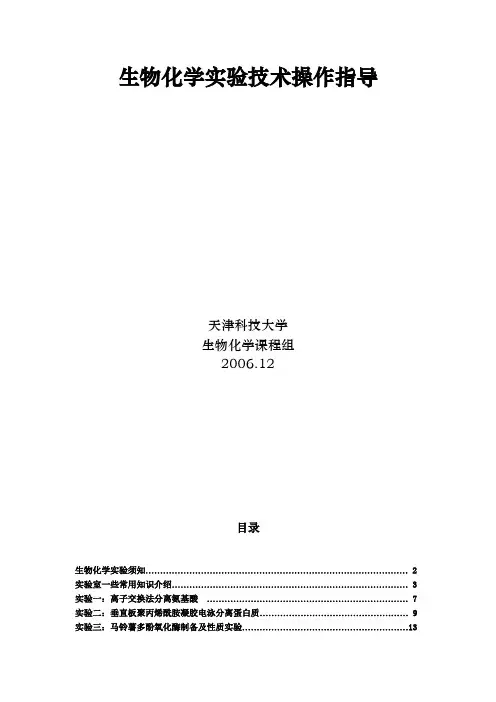
生物化学实验技术操作指导天津科技大学生物化学课程组2006.12目录生物化学实验须知⋯⋯⋯⋯⋯⋯⋯⋯⋯⋯⋯⋯⋯⋯⋯⋯⋯⋯⋯⋯⋯⋯⋯⋯⋯⋯⋯⋯⋯⋯ 2实验室一些常用知识介绍⋯⋯⋯⋯⋯⋯⋯⋯⋯⋯⋯⋯⋯⋯⋯⋯⋯⋯⋯⋯⋯⋯⋯⋯⋯⋯⋯ 3实验一:离子交换法分离氨基酸⋯⋯⋯⋯⋯⋯⋯⋯⋯⋯⋯⋯⋯⋯⋯⋯⋯⋯⋯⋯⋯⋯⋯ 7实验二:垂直板聚丙烯酰胺凝胶电泳分离蛋白质⋯⋯⋯⋯⋯⋯⋯⋯⋯⋯⋯⋯⋯⋯⋯⋯⋯ 9实验三:马铃薯多酚氧化酶制备及性质实验⋯⋯⋯⋯⋯⋯⋯⋯⋯⋯⋯⋯⋯⋯⋯⋯⋯⋯⋯13实验四:碱性蛋白酶活力的测定⋯⋯⋯⋯⋯⋯⋯⋯⋯⋯⋯⋯⋯⋯⋯⋯⋯⋯⋯⋯⋯⋯⋯16 实验五:植物组织中DNA和RNA的提取和鉴定⋯⋯⋯⋯⋯⋯⋯⋯⋯⋯⋯⋯⋯⋯⋯⋯19实验六:糖酵解中间产物的鉴定⋯⋯⋯⋯⋯⋯⋯⋯⋯⋯⋯⋯⋯⋯⋯⋯⋯⋯⋯⋯⋯⋯⋯⋯22实验七:综合设计实验—蛋白质的制备及其含量测定⋯⋯⋯⋯⋯⋯⋯⋯⋯⋯⋯⋯⋯⋯⋯24 实验八:还原糖和总糖的测定(3,5-二硝基水杨酸法)⋯⋯⋯⋯⋯⋯⋯⋯⋯⋯⋯⋯⋯35实验九:发酵过程中无机磷的利用⋯⋯⋯⋯⋯⋯⋯⋯⋯⋯⋯⋯⋯⋯⋯⋯⋯⋯⋯⋯⋯⋯⋯37实验十:氨基酸的分离鉴定—纸层析法⋯⋯⋯⋯⋯⋯⋯⋯⋯⋯⋯⋯⋯⋯⋯⋯⋯⋯⋯⋯⋯39 实验十一:细菌血栓溶解酶活性测定⋯⋯⋯⋯⋯⋯⋯⋯⋯⋯⋯⋯⋯⋯⋯⋯⋯⋯⋯⋯⋯⋯41 实验十二:可溶性糖的硅胶G薄层层析⋯⋯⋯⋯⋯⋯⋯⋯⋯⋯⋯⋯⋯⋯⋯⋯⋯⋯⋯⋯⋯43 实验十三:植物材料中总黄酮的提纯与鉴定⋯⋯⋯⋯⋯⋯⋯⋯⋯⋯⋯⋯⋯⋯⋯⋯⋯⋯⋯44 实验十四:IEF/SDS-PAGE双向电泳分离鉴定蛋白质⋯⋯⋯⋯⋯⋯⋯⋯⋯⋯⋯⋯⋯⋯⋯45附录⋯⋯⋯⋯⋯⋯⋯⋯⋯⋯⋯⋯⋯⋯⋯⋯⋯⋯⋯⋯⋯⋯⋯⋯⋯⋯⋯⋯⋯⋯⋯⋯⋯⋯49一、实验室主要仪器使用操作规程与注意事项⋯⋯⋯⋯⋯⋯⋯⋯⋯⋯⋯⋯⋯⋯⋯⋯⋯⋯49二、常用缓冲溶液的配制⋯⋯⋯⋯⋯⋯⋯⋯⋯⋯⋯⋯⋯⋯⋯⋯⋯⋯⋯⋯⋯⋯⋯⋯⋯⋯⋯55三、硫酸铵饱和度的常用表⋯⋯⋯⋯⋯⋯⋯⋯⋯⋯⋯⋯⋯⋯⋯⋯⋯⋯⋯⋯⋯⋯⋯⋯⋯⋯60生物化学实验须知1.实验室规则(1) 实验课必须提前5分钟到实验室,不迟到,不早退,应自觉遵守课堂纪律。
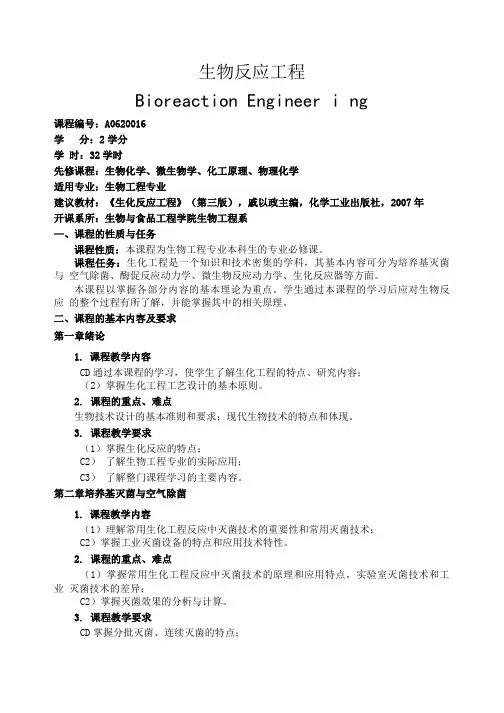
生物反应工程Bioreaction Engineer i ng课程编号:A0620016学分:2学分学时:32学时先修课程:生物化学、微生物学、化工原理、物理化学适用专业:生物工程专业建议教材:《生化反应工程》(第三版),戚以政主编,化学工业出版社,2007年开课系所:生物与食品工程学院生物工程系—、课程的性质与任务课程性质:本课程为生物工程专业本科生的专业必修课。
课程任务:生化工程是一个知识和技术密集的学科,其基本内容可分为培养基灭菌与空气除菌、酶促反应动力学、微生物反应动力学、生化反应器等方面。
本课程以掌握各部分内容的基本理论为重点。
学生通过本课程的学习后应对生物反应的整个过程有所了解,并能掌握其中的相关原理。
二、课程的基本内容及要求第一章绪论1.课程教学内容CD通过本课程的学习,使学生了解生化工程的特点、研究内容;(2)掌握生化工程工艺设计的基本原则。
2.课程的重点、难点生物技术设计的基本准则和要求;现代生物技术的特点和体现。
3.课程教学要求(1)掌握生化反应的特点;C2)了解生物工程专业的实际应用;C3)了解整门课程学习的主要内容。
第二章培养基灭菌与空气除菌1.课程教学内容(1)理解常用生化工程反应中灭菌技术的重要性和常用灭菌技术;C2)掌握工业灭菌设备的特点和应用技术特性。
2.课程的重点、难点(1)掌握常用生化工程反应中灭菌技术的原理和应用特点,实验室灭菌技术和工业灭菌技术的差异;C2)掌握灭菌效果的分析与计算。
3.课程教学要求CD掌握分批灭菌、连续灭菌的特点;C2)理解微生物的热死灭动力学;(3)理解空气过滤设计的原理;(4)掌握典型空气除菌流程。
第三章均相酶促反应动力学1.课程教学内容(1)掌握均相酶促反应动力学特点;(2 )了解有各种抑制剂存在的酶促反应动力学特点o2.课程的重点、难点(1)掌握方程的推导及应用;(2)熟悉有抑制的酶催化反应动力学。
3.课程教学要求(1)掌握典型酶促反应过程的特点及相关公式;C2)掌握影响酶催化反应速率的因素;C3)理解米氏方程动力学参数的求取;(4)理解有各种抑制剂存在情况下的酶反应特征。
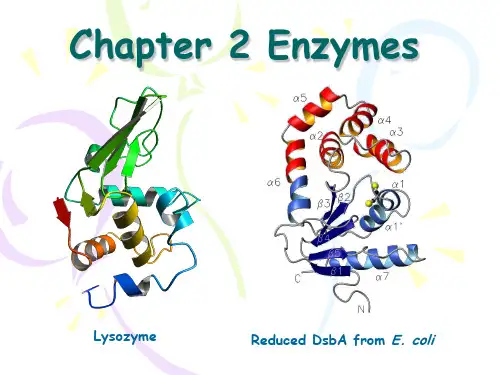

《生物反应工程》课程新大纲和内容英文名称:Bioreaction Engineering学分:3.5学分学时:55学时理论学时:35学时实验学时:20学时教学对象:生物工程本科专业学生先修课程:高等数学、生物化学、微生物学教学目的:使生物工程本科专业的学生,在学完本专业基础课生物化学和微生物学的基础上,针对本专业工科培养的目标,学习生物反应工程的基础知识、基本概念、基本理论及基本方法,学会如何分析在各类反应器中进行的生化反应过程中出现的各种现象,并学会生化反应过程的调控、生物反应器放大设计,为今后从事工业生产和科学研究打下坚实的基础。
教学要求:掌握生化反应过程中的基本概念,各种生物反应过程中的动力学分析以及生物反应过程中的代谢分析;掌握生物反应器的基本概念,生物反应器分析和设计的基本原理和基本方法,并能应用这些原理和方法进行反应器的基本设计和对简单反应过程进行定性分析,进行其操作的优化;掌握生物反应器操作和控制的基本技能。
上篇生物反应过程分析第一章绪论(4学时)基本要求:从典型生物反应过程的分析和设计出发,让学生:了解各组成部分的任务、目的和要求。
明确生物反应工程的研究对象和任务。
了解生物反应工程的研究方法,掌握生物反应器放大设计的基本方法。
掌握反应工程一些基本概念:底物,产物;反应转化率,收率,选择性。
重点:明确和掌握生物反应工程的研究对象、任务和生物反应器放大设计的基本方法。
掌握反应工程一些基本概念。
主要内容:1.1 生物反应过程概述典型生物反应过程生物反应过程分类1.2 生物反应工程研究对象、研究内容和任务、研究方法、生物反应器放大设计的基本方法1.3 反应工程的基本概念底物,产物;反应转化率,收率,选择性。
第二章生物反应动力学(8学时)基本要求:掌握简单酶催化反应动力学、有抑制的和复杂的酶催化反应动力学,掌握影响酶催化反应速率的因素,以及动力学参数的求取。
了解微生物反应过程的计量学,掌握分批培养时细胞生长动力学、底物消耗及产物生成动力学,学会细胞反应动力学参数的估算。